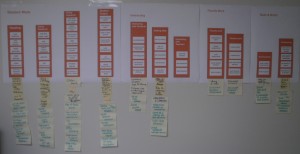Overview
A couple of weeks ago INFLUX was in town to provide us with a short presentation to discuss the user interviews, mental model findings and a short brainstorming session. Prior to my arrival at SUNY Potsdam INFLUX was contacted to help the libraries to learn more about the people at the college. Over the past few months they conducted user interviews with 12 different people from the college community.
The interviews were conducted using Skype during the summer and fall of last year. The interviews were open conversations giving an outside organization to learn more about the different things that people do at the college that lead to the creation of a mental model. This information also helped them to create persona for seven different people.
Persona’s
Persona’s are necessary to learn about the people who will be using your website and why they would use it.
Music Graduate Student – 26 years old
“I’m all over campus. Sometimes I’m in a practice space, sometimes I’m looking for good wifi, and sometimes I’m too exhausted to go anywhere so I do research at home.”
Goals:
- Find a job in my filed
- Get as much content as I can on-line for all my classes
- Get better at narrowing down my research focus
- Get better at keeping up with the research happening in my field
Mental Model
INFLUX lead us through the mental model that was created based upon the interviews that where conducted. The mental model was created on three large pieces of paper that represented the following Student Work, Interacting, Faculty Work, and Nuts & Bolts. Each of these four areas was broken down into further categories.
Here is a top level list of the items that people are doing here at SUNY Potsdam:
- Student Work
- Reading
- Doing Research
- Student Output
- Interacting
- Interacting with Students
- Getting Help
- Interacting with Teachers
- Faculty Work
- Faculty Work
- Nuts & Bolts
- Working Mode
- Scheduling
After briefly discussing the mental model, we were asked how the library was able to support the various different items that were listed. Some examples include; Access to patron account, access to hours, and on-line resources. We were asked to write these items down on a post it note and to place it underneath each category that the item helped support. The next step was to write down items that the library is currently not doing to support the different tasks that people are doing. For example, computer availability map to support “Working Mode” and new services for faculty web page to help support “Faculty Work”.
One we were finished working through this process we had several post it notes sitting under each category except for “Interacting with Teachers” because these items where already being supported by the university.
Conclusion
The most important think to keep in mind is that the interviews asked very generic questions to help learn more about the people who make up the SUNY Potsdam community. There are several items that appear within the mental model that occur on a daily basis that do not involve a website or technology at all. For example, most of us will set an alarm, tie a bow around our finger, or write a short note to remind us to do something. The information provided by INFLUX will be very helpful in creating a new website.
More images of the mental model can be viewed by going to our Picasa Mental Model Web Album.